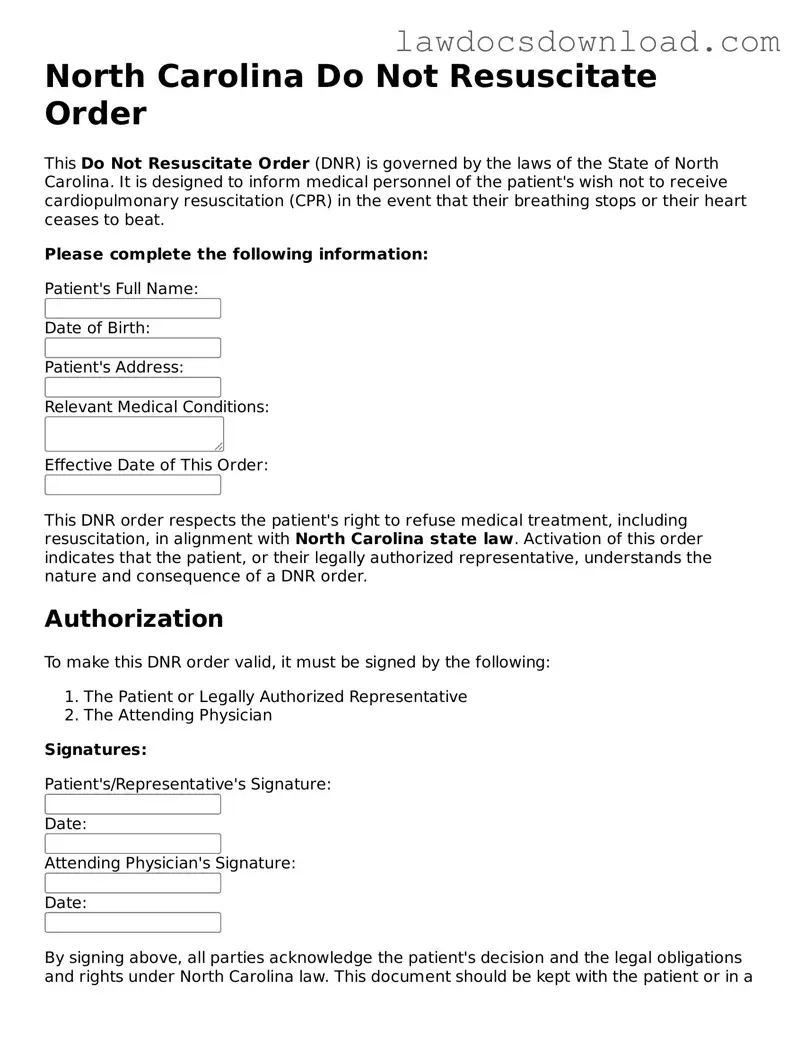The North Carolina Do Not Resuscitate (DNR) Order form shares similarities with the Advanced Directive for Natural Death, commonly known as a Living Will. Both documents detail a person's preferences for medical treatment should they become unable to communicate those preferences themselves. While the DNR specifically addresses the desire not to have CPR in the event of a cardiac or respiratory arrest, a Living Will covers a broader range of life-prolonging treatments.
The Medical Power of Attorney (MPOA) is another document closely related to the North Carolina DNR Order. The MPOA authorizes another person to make healthcare decisions on behalf of someone if they are incapacitated. It operates alongside the DNR Order, delineating who can decide about initiating or withholding treatments as per the patient's wishes, including but not limited to resuscitation efforts.
The Five Wishes Document, though more comprehensive, has aspects that overlap with the North Carolina DNR Order. It goes beyond specifying medical treatments, addressing personal, spiritual, and emotional wishes alongside medical ones like the DNR. Both documents serve to communicate the patient’s healthcare preferences to family, friends, and medical providers.
Health Care Proxy forms, similar to the MPOA, appoint a person to make healthcare decisions on the patient's behalf. This proxy might be tasked with enforcing the wishes laid out in a DNR Order, ensuring that the patient’s choices regarding resuscitation and other life-sustaining measures are respected, even when they cannot speak for themselves.
The Physician Orders for Life-Sustaining Treatment (POLST) form is akin to the DNR Order but is broader. It covers a range of treatments, including but not limited to resuscitation. Both forms are designed to ensure that healthcare providers are aware of and respect the patient’s treatment preferences in critical situations.
Do Not Intubate (DNI) orders are closely related to DNR Orders as they specify a patient's wish to avoid certain life-sustaining treatments—specifically, intubation. While the DNR focuses on CPR, both documents guide medical personnel on the withholding of specific interventions.
The Organ Donor Card can be considered in tandem with the DNR Order because both documents express critical healthcare preferences. While the DNR Order indicates a patient's wish not to receive CPR, an Organ Donor Card specifies the individual's desire to donate organs posthumously, another vital decision about one's body and medical treatment.
A Last Will and Testament, while primarily focused on the distribution of assets, shares a fundamental similarity with the DNR Order in that it expresses an individual's wishes to be carried out after they are no longer able to communicate or have passed away. Both documents help ensure that personal wishes are respected and followed.
The HIPAA Authorization Form does not deal directly with treatment preferences but is related to the DNR Order through its function of allowing or restricting the sharing of one's health information with specified individuals. By controlling who can access their medical information, a patient can ensure that only those who are informed about and supportive of their healthcare wishes, like a DNR Order, are kept in the loop.
Finally, the Emergency Medical Services (EMS) Do Not Resuscitate Order is a document specifically intended for emergency medical professionals, similar to the hospital or facility-based DNR Order but used in out-of-hospital settings. This document ensures that a patient's wish not to undergo CPR is respected by first responders and emergency personnel, just like the standard DNR Order does within healthcare facilities.
